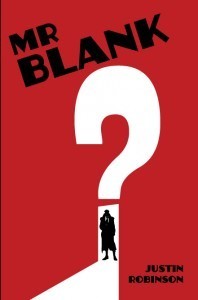Justin Robinson's Blog, page 31
September 18, 2012
Pre-Order Extravaganza
Pre-orders for Mr Blank are going strong…but they could use a little boost to get to $1,500! Y’see, if we make it to $1,500 in pre-orders, Justin is going to be forced (possibly at baseball-bat-point) to write a tie-in story that will go out to all backers at $35 and up.
That’s in addition to all the rewards currently out there – things like a Mystery Grab Bag and a keychain featuring the weapon used to assault Our Narrator.
C’mon, with a deal like that, how can you hold back?
September 14, 2012
Jodie Foster’s Beaver
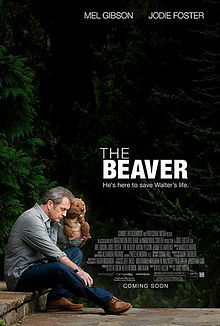
What’s that? Shoot my neighbor?
The Beaver was intended as a very specific kind of movie: one in which rich white people have the kind of problems the rest of us just sort of deal with, only these drama queens have to resort to something ridiculous. In this case, Mel Gibson uses a beaver puppet to talk through his problems in a Michael Caine voice.
Tagline: He’s here to save Walter’s life.
More Accurate Tagline: He’s the last nail in the coffin of Mel Gibson’s career.
Guilty Party: It would be tempting to blame Mel Gibson for this one, since his public meltdowns lend the film a queasy quality of voyeurism. It’s not as much fun watching someone legitimately unhinged play a crazy person. Gibson, however, is merely a symptom. This one is the fault of Jodie Foster, who took a script that could have been an ideal vehicle for Steve Carrell or Jim Carrey (both men were considered for the lead role) and turned it into a dour meditation on depression. Foster doesn’t seem to understand that a man wielding a puppet is funny, and moreover doesn’t understand what the fuck you people are laughing at.
Synopsis: Walter Black (Gibson) is the kind of asshole who uses “summer” as a verb. He lives in a huge house, runs his own company, has a wife and two sons, but is horribly depressed, the reasons for which are never explored. The film makes passing reference to his father’s suicide when he was young, and he mentions at one point that he was not ready to take over as president of the company (A toy company! Oh, the delicious whimsy!), but it really comes off that Walter is filled with ennui about his awesome life. I’m left to conclude that one night at Ruth’s Chris, he ordered the ’65 Bordeaux and got the ’67 and was sent into a downward spiral of shame and rage that eventually crushed his psyche.
His wife Meredith (Foster) kicks him out of the house, and he attempts suicide. In the pit of depression, a beaver puppet he found in the garbage starts talking to him. The next morning he returns to his family talking through the puppet and carrying a forged doctor’s note explaining the puppet helps him gain distance from the negative aspects of his personality.
The little doctor’s note apparently contains a magic spell, because once Walter shows it to anyone, they immediately regard the fact that a grown man is talking to them from a beaver puppet as a charming eccentricity. Walter reconnects with his younger son over a newfound shared love of woodworking, with his wife over not being such a self-absorbed asshole all the time, and with his job by… showing up, I guess? It’s not really clear. The only thing missing from this parade of scenes is a happy montage set to “Walking on Sunshine.”
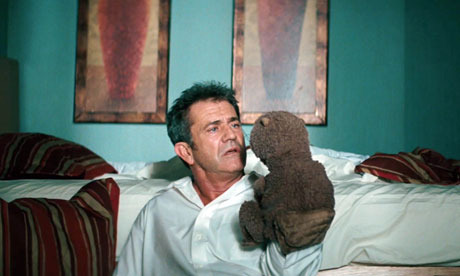
Masturbation just got a lot more complex.
The only person who isn’t buying Walter’s sudden transformation is his son Porter (Anton Yelchin). This kid hates his dad so much he keeps a list of all the ways they’re similar, and periodically headbutts a growing hole in his bedroom wall. Porter has a job writing papers for other kids, charging $200 a pop. $200 in high school was more money than I’d see in a year, but whatever. The head cheerleader/valedictorian (Jennifer Lawrence) can’t deliver her speech, and so pays Porter $500 for it. Good fucking Christ. How many websites is she doing porn on that she can afford that? So they start a romance thing, leading to me calling them J-Law and the Yelch.
Eventually, Meredith figures out that no therapist in his right mind would prescribe a puppet, and leaves Walter for lying to her. Walter loses what’s left of his mind and cuts his hand off. Because just taking off the puppet would be too easy, I guess. Oh, well. And in the end, everything is fine, only Walter is in a mental institution and jobless.
Life-Changing Subtext: Evil lies in your left, or sinister, hand.
Defining Quote: “You give the word, we’ll make the turd.” — The Beaver. I like to think someone said this to Jodie Foster in the development stage.
Standout Performance: Mel Gibson as Walter Black and the Beaver. Gibson is a man of outsized charisma, in the sense that whatever emotion he wants to convey, be it happiness, depression, or rage that his Russian girlfriend isn’t blowing him, comes through crystal clear. In The Beaver he turns off the charisma entirely, showing the hollow man inside. It’s the wrong choice for the material, but it’s still interesting.
What’s Wrong: I touched on this briefly, but it bears repeating: with the possible exception of Porter, no one reacts to Walter in a realistic way. There is usually a momentary furrowing of the brow to indicate that this is a serious film, and a man using a beaver puppet to do a cockney accent is a little queer, but that’s quickly dispelled as the magic of the Beaver sweeps everyone along on a magic stream of cockney pixie dust.
Additionally, this is a film about rich white people, by rich white people, and for rich white people, so a simple victory is not enough for it. Not only is Walter’s personal life floundering in the opening, but his company is dying as well. So he hatches the brilliant idea of selling woodworking kits to children, and of course these become huge runaway successes. And when Walter appears in interviews with the puppet, he becomes a media sensation rather than laughingstock. It’s wish fulfillment for people who already have everything.
Flash of Competence: I imagine Jennifer Lawrence in a cheerleader outfit probably qualifies.
Best Scenes: J-Law and the Yelch are in their own film. J-Law is a talented artist (as well as being a cheerleader and valedictorian and oh my god I hate these people so much) but she’s hidden it away ever since her brother killed himself with drugs. The Yelch takes it upon himself to bring this side of her out. With almost the same cast — except the parents would have been the parents from Ferris Bueller or something — this would be a perfect Afterschool Special . J-Law right before Winter’s Bone, the Yelch right before Star Trek. I’m getting upset just thinking about it. Let’s move on.
All right, so Walter’s relaunch of the toy company centers around giving a bunch of kids sharp objects and a block of wood. This isn’t his biggest dick move. Nope, when he first arrives at the company with the beaver puppet, he pledges that he’s returning control of the projects to the teams. Then, without warning, takes them away again to produce the woodworking kits. Ever think that being a self-absorbed prick is what got you in trouble in the first place? And sadly, there is no montage of lawsuits involving nine-fingered children.
After Meredith leaves him, Walter turns on the Beaver. What follows is a fight scene between a man and the puppet on his arm. Hilarious, right? Well, someone tell the music guy, because the dirge playing makes this sound like a scene from Braveheart.
Transcendent Moment: Once Walter puts on the puppet, he never takes it off. Never. This includes the scene where he reconnects with his wife. Using his dick. Oh yes, there is a sex scene in which Mel Gibson’s Beaver goes down on Jodie Foster’s Beaver. And if that weren’t enough, they go for a menage in the shower. It’s like watching your parents have sex. With a beaver puppet.
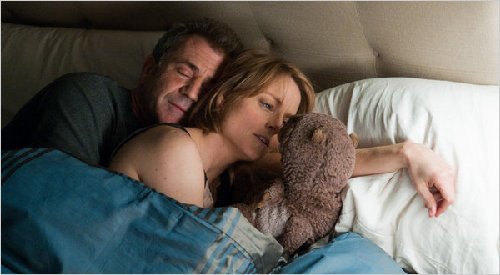
Let’s run away to your dam.
The Beaver was sunk by the toxic press of its star, but it is terrible for so many other reasons that have nothing to do with anti-semitism or domestic violence. It’s what happens when Oscarbait goes horribly, hilariously awry.
Louis talks about these kinds of movies in his series on Stupid White People. Or check out another review of a misguided film.
Filed under: Projected Pixels and Emulsion, Yakmala! Tagged: Anton Yelchin, Jennifer Lawrence, Jodie Foster, mel gibson, Oscar bait gone wrong, The Beaver, Yakmala!

September 7, 2012
Very Special Blossom: Sex, Lies and Teenagers
“Did you see her?” I said to Mrs. Supermarket. “I think she’s from 1995.”
“That’s where the hipsters are now,” she said, unconcerned. “They made it to the nineties.”
“Oh, good. No one tell them about System of a Down.”
It’s become a common sight around the hipster infested areas of East LA: otherwise attractive women with messy updos, semi-diaphanous black tops, and earth-toned shorts hiked up to their armpits. At a restaurant in Eagle Rock, our waitress looked like she stepped off the set of Zandalee. And what I can’t understand is that these fashions sucked the first time around, so why would anyone want to go back? ‘90s fashion grew out of the AIDS pandemic and the safe sex movement. This was back when any sexual contact would immediately get your penis haunted, and you’d need Zelda Rubenstein to clear that shit up. That’s if I remember my high school health class correctly. Anyway, these were birth control clothes, designed to destroy any vestige of sexual impulse. Unless you’re a Catholic preteen, you have no earthly reason to dress like this.
I bring it up because of this week’s Very Special Blossom, “Sex, Lies and Teenagers” (season 1, episode 5). The absence of the oxford comma implies that this will be about sex on one hand, and lies and teenagers on the other. It conjures images of Nick Russo having sex, then lying to teenagers Joey, Blossom, and Six about it. Or perhaps Nick realizes that the time to have “the talk” is long overdue for his fourteen year old daughter, and then lying extravagantly about what goes into sex in the misguided hope she will join a convent. Sadly, no, this is all about our young heroine (who only just became a woman literally four episodes ago), taking her first few steps on the road to Pleasure Town.
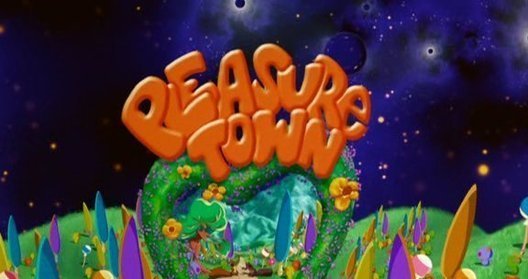
“There’s a rainbow! Do me on it!”
While I have a few things to say about teenaged sexuality that will likely get me added to a couple watchlists, the primary purpose of watching these things are as time capsules. Which is why I bring up the fashions, because this is the first episode where I looked at them and realized, holy living fuck, people actually left the house dressed like that. There’s a very simple truism with regards fashion in television and movies: the less cool your character is supposed to look, the better his fashion sense will age. The best example comes from the ‘80s cable staple Just One of the Guys, in which one of the dorky characters dresses in vintage bowling shirts and slacks, a proto-hipster chic that would not look out of place on the streets today. He gets a makeover in the film to become a paragon of ‘80s excess, and ends up looking like he should be sucking off the members of Roxy Music. In Blossom, the uncool adults don’t look terrible, even if their shirts are too loose and their pants are upsettingly tight. Joey and Tony fare a little worse, with tight, ripped jeans about an inch too short, and in Tony’s case, a vest over his t-shirt. The real victim in all this is Blossom. Oh, poor Blossom.
It’s generally a bad sign if I can’t even identify what a garment is supposed to be. I mean, I’m no expert, but I know about dresses, and skirts, and shorts, if only because my existence is pretty much focused around determining which of these my wife is wearing and attempting to get it off of her. For Blossom’s trip to the make out party at the center of the episode (for which everyone says she looks incredible), she wears a blazer over a piece of clothing whose floral print is the same color as Linda Blair’s vomit. I couldn’t figure out what the hell it was for the longest time. Skirt? Dress? Shorts? Then, with mounting horror, I came to the conclusion that it was a jumper.
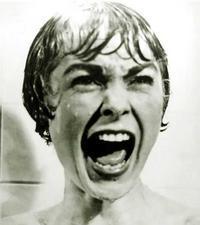
And I made this face.
None of this is what the episode is supposed to be about. No, Blossom wants to attend her first make out party with a fetal Johnny Galecki, but is of course nervous about what will be required of her. There’s even a place in the infamous house referred to in hushed tones as “The Room.” Predictably, I immediately pictured Tommy Wiseau waiting in the darkness, ready to have some Borat-inflected meltdown. No wonder Blossom’s worried! No one wants to make out in front of Tommy. The “lies” in the title refers to Blossom’s lie to her father about the make out party, and presumably, about the likely presence of a future cult film director and possible vampire. After he discovers the deception, they have a blow up where they basically agree that lying to your parents is natural and is just part of the relationship now.
Wait, what?
That’s right, this Very Special Blossom wants to impart the lesson that lying is a-okay! Well, lesson learned, Miss Russo. Lying is a perfectly natural part of the parent-child relationship, and one that while not necessarily treasured, should be tacitly understood. The way you don’t go into mom’s room when her special friend spends the night.
As always, a few familiar faces popped up. I mentioned Johnny Galecki, but the guy is seriously young here. I kept expecting his voice to crack. The second recognizable face is Brenda Strong, an actress who has carved out a respectable career mostly on television, with her most famous role probably as the dead narrator on Desperate Housewives. Here she plays a love interest for divorced Nick, who is immediately cockblocked by his children. The most recognizable face belongs to a near-extra who has a single line and is credited as “Boy.” His screentime is so brief, I didn’t even recognize him until I saw the name in the credits: Tobey Maguire. This has to be the answer to some obscure trivia question somewhere.
Maybe instead of Blossom you watch Dr. Who. Or maybe you want to go even cheesier and check out an CBS Schoolbreak Special.
Filed under: Projected Pixels and Emulsion Tagged: lies, makeout parties, sex, teenagers, Very Special Blossom

September 4, 2012
Publishers Weekly Review
Publishers Weekly is lovin’ Mr Blank, a “sassy crime caper” – check it out!
The smart-aleck narrator of this sassy crime caper is an agent who uses so many aliases for his work in the information underground that his real name is never certain.
August 31, 2012
The Best Movies Never Made: Caveman Cop
Godfrey Ho
Writer
Amir Shervan
Starring
Gabriel Gonzaga, Michael Winslow, Maria Conchita Alonso, Taylor Negron, Brigette Neilsen, Edward James Olmos
Synopsis
Caveman Cop (Gabriel Gonzaga) work Narco in LA. Caveman Cop big. Caveman Cop bad. Caveman Cop have awesome arrest record. Caveman Cop like 50,000 years old or something. Not mentioned. Not important.
Caveman Cop always get his man. Use homemade stone spears, not that gun department give him. Evil spirit in gun. Make loud noise. Frighten Caveman Cop.
Year 1988. Caveman Cop on trail of heroin smuggling ring. Only now Caveman Cop have to break in new Black Partner (Michael Winslow). Caveman Cop too old for this shit. See, Captain (Maria Conchita Alonso) upset about Caveman Cop cavalier approach to “rules” and “regulations.” Caveman Cop play by own rules. Pleistocene rules. Caveman Cop cause massive amount of property damage. Caveman Cop hoot and wail. Caveman Cop forget to Mirandi… Mirand… Mi… tell bad man what can and can’t do. Caveman Cop lose more convictions that way.
Caveman Cop also cop on edge. Break into La Brea Tar Pit. Visit wife, Caveman Cop Wife (Brigitte Neilsen in flashbacks). Cry a lot. Drink fermented caribou milk because no one tell Caveman Cop about whiskey.
Caveman Cop and Black Partner investigate simple drug deal gone wrong. Turn out to be large conspiracy surrounding Mayor of Los Angeles (Edward James Olmos). Mayor have Creepy Goon (Taylor Negron) in charge of all heroin in LA. Not on Caveman Cop watch!
Caveman Cop have sex scene with stripper. It… not pleasant.
Caveman Cop and Black Partner get too close to Mayor business. Send Creepy Goon after them. Caveman Cop lose spear. Fortunately, Black Partner there to save ass. Caveman Cop begin appreciate Black Partner.
Caveman Cop and Black Partner go have shoot out with Mayor and army of goons. Caveman Cop have spear again. Use stone tools. Say cool stuff.
Gun battle spills into neighboring La Brea Tar Pits. Mayor take Caveman Cop Wife hostage. Well, take bones hostage, anyway. Caveman Cop not have move. Black Parter save day by shooting Mayor arm. Then Caveman cop impale Mayor on mammoth tusk and drop him into tar. Then Caveman Cop, Black Partner, and bones of Caveman Cop Wife have drink.
Trivia
Two Oscar nominations, 1 win (for Best Sound Editing). Oscar later revoked when it was discovered the sound effects were all co-star Michael Winslow working with Mercedes McCambridge.
Black Partner’s badge number is 714, the same as Detective Joe Friday’s on Dragnet.
Originally pitched as a sequel to Gandhi.
Caveman Cop’s wife is a fossilized skeleton of an elderly Cro-Magnon man currently on display in Balboa Park, San Diego.
Black Partner’s name is never revealed. Whenever he or another character is about to say it, Caveman Cop cuts them off. This becomes an in-joke in the sequels.
The cave paintings Caveman Cop paints on the bathroom stalls were done by famed street artist Omar Omar.
Caveman Cop’s cave on the cliffs of Malibu was swallowed up by a mudslide in 1993.
Though never stated in the film, Caveman Cop is intended to be Archaic Homo sapiens, a possible subspecies of anatomically modern humans.
The studio originally wanted Werner Herzog, but balked when he tried to cast Uwe Boll as the title role. Instead, they turned to their second choice, Sam Firstenberg, director of the popular Ninja III: The Domination. He briefly cast a young Tommy Wiseau, but through a combination of nepotism and intrigue, was replaced by the final cast and crew.
Due to a mix up at the recording studio, Caveman Cop’s voice was dubbed by Casey Kasem in the European release and Christopher Lambert in the American.
Narrowly avoided an X rating by cutting away during the Mayor’s impaling and tar-drowning death.
Goofs
Plot holes: Caveman Cop somehow knows that Creepy Goon is allergic to sunflower seeds, despite never hearing that information
Boom mic visible: during the Lascaux freakout scene
Factual errors: Cavemen seldom lived past forty, and never reached their 50,000th birthday.
Factual errors: Caveman Cop’s toolmaking skills were not advanced enough for his species, although it is possible he is just stupid.
Factual errors: Cavemen weren’t like that. At all.
Errors made by characters (possibly deliberate errors by the filmmakers): “Creepy Goon” is not an actual job title for City Hall employees in Los Angeles
Revealing mistakes: In flashback, when Caveman Cop wrestles the sabretooth, one of the teeth comes out.
Errors in geography: Santa Monica is not Downtown
Errors in geography: The mayor’s Beverly Hills estate is depicted as being right next to the La Brea Tar Pits. This is not possible.
Errors made by characters (possibly deliberate errors by the filmmakers): Caveman Cop believes that most modern amenities, including (but not limited to) cars, coffee makers, books, firearms, and Methodists are evil spirits. This is not true.
Memorable Quotes
The Captain: I don’t like your methods, Caveman Cop, but you get results!
The Captain: (referring to Black Partner) Caveman Cop, this is your new partner, Detective–
Caveman Cop: Caveman Cop not have time for this!
(repeated line) Black Partner: Shit!
Caveman Cop: Time make Mayor extinct.
(repeated line) Black Partner: Damn!
Caveman Cop: Caveman Cop here to hunt mammoth and kick ass. And Caveman Cop all out of mammoth.
Selected Reviews
“Offensive to cavemen. Somehow.”
-Dr. Richard Leakey
“Gog like.”
-Gog
“A lyrical meditation on the nature of law enforcement and early man.”
-Armond White
For another one of the greatest movies never made, check out ’89 Bullets. Or check out the kind of movie that inspired Caveman Cop in the Stallone Diary.
Filed under: Projected Pixels and Emulsion Tagged: '80s action flicks, Caveman Cop, the Best Movies Never Made

August 30, 2012
Hear ye, hear ye!
Mr Blank author Justin Robinson goes on the record…and gets a tiny bit of his soul captured, as you do, by participating in a new podcast, Books & Shit.
August 24, 2012
The Might-Be Avengers
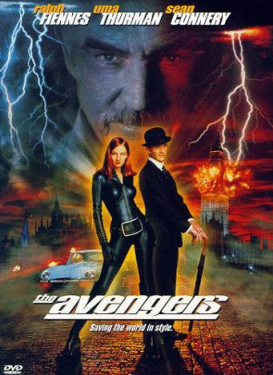
“We escaped from Connery’s mustache! Help!”
The Avengers is one of those movies that really should have been great. Combining an excellent cast with a geek-friendly pedigree and some inspired weirdness should have birthed an instant cult classic. Yet the movie is forgotten almost as soon as you’re done with it, with only isolated images remaining. I should point out that I’m talking about the 1998 would-be blockbuster starring Ralph Fiennes, Uma Thurman, and Sean “I passed on Lord of the Rings” Connery.
Tagline: Extraordinary crimes against the people and the state must be avenged.
More Accurate Tagline: Mmm… quite.
Guilty Party: This mess reeks of studio meddling. The Avengers television show, from what I’ve been able to understand, was never going to spawn an American blockbuster. It’s too weird, and that specific brand of tweedy British weird, for mass appeal. Had it been turned into a middle-to-low budget thriller with endearingly clunky special effects, it could have turned into the kind of thing that airs on IFC to rapturous trash-art connoisseurs like me. Instead, the studio saw something truly offbeat and trimmed it into oblivion, producing a finished product that doesn’t make a lick of sense. Producer Jerry Weintraub, this is your fault.
Synopsis: This synopsis is going to feel weird, disjointed, and incomplete. It has to be accurate to the film.
The British are in trouble! They don’t want to be a bother, but Dr./Mrs. Emma Peel (Uma Thurman), former chief of the Prospero Program (which has something to do with weather, I think) has apparently sabotaged the selfsame program. Sabotaged it how? Who knows? The Ministry, a counter-espionage organization, have her on video and everything. So instead of, I don’t know, arresting her, they decide the most reasonable course of action is to send her off alone with their top man John Steed (Ralph Fiennes) to find out what the problem is. The investigation starts with Sir August de Wynter (Sean Connery), some crazy recluse guy who has an unexplained picture of Uma Thurman on his pipe organ.
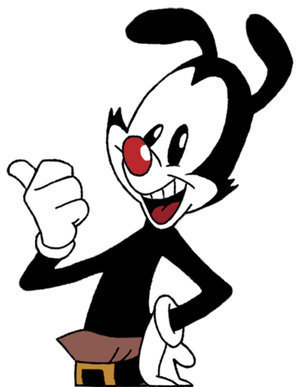
Good night, everybody!
While Mrs. Peel has a murky conversation with de Wynter, Steed is ambushed and shot by Mrs. Peel. He wakes up later in Mrs. Peel’s house, and accepts her alibi, despite, you know, SEEING her shoot him. We clearly have an evil twin situation brewing here, but neither Uma has a goatee. Anyway, Mrs. Peel stole one of de Wynter’s snowglobes (because he collects snowglobes since he’s delightfully eccentric) that has a Wonderland Weather logo. So based on evidence Encyclopedia Brown would dismiss as circumstantial, they wander into a company that apparently sells custom weather, and all you have to do to get an unescorted tour is drop de Wynter’s name.
Meanwhile, upstairs, de Wynter is having a meeting with his entire evil organization while dressed in teddy bear suits. Seriously. This is something that happens. De Wynter kills a couple of his underlings who are having cold feet about the plan. Steed and Peel, now upstairs — I don’t know either — split up, Steed to stop a red teddy bear who waves to him, and Peel to the roof to… I’m not really sure. They both end up in fights, Steed with Eddie Izzard for some reason, and Peel with her evil twin who is also in a teddy bear suit. Still no goatee.
This is right about where the movie completely falls apart into a series of sketches about the dangers of CGI in the British countryside. It turns out Father, one of the two heads of the Ministry, is in cahoots with de Wynter (explained during a croquet scene). They capture Emma Peel and try to drive her crazy, and it turns out the twin is a clone, which they explain with a picture of a two-headed calf for some reason. There’s also a chase with some robot bugs where the heroes are saved by an old British lady and her tommy gun.
Tired of all this, de Wynter goes to a big room filled with world leaders, which is totally a thing in movies like this, and informs them that they will buy weather from him, or he’ll basically pull a Day After Tomorrow. Steed and Peel, remembering what a piece of shit that flick was, spring into action. They first take out Father and Clone Peel, which succeeds chiefly due to Emma Peel’s never-before-revealed immunity to falling.
Steed and Peel head over to de Wynter’s evil lair. Peel has a tightrope fight against Eddie Izzard and predictably wins, because she’s played by Uma Thurman and he’s played by Eddie Izzard. Steed has a duel with de Wynter and wins due to some timely assistance from lightning.
Life-Changing Subtext: The apocalypse isn’t anything to get worked up about. Tea?
Defining Quote: “Would you be so kind as to hit the ground if it’s not too much trouble?” — Alice, while brandishing a Thompson. This kind of dialogue is a tightrope. It’s either delightful or completely unsufferable. Sadly, the film falls on the latter end of the scale. A lot.
Standout Performance: Eileen Atkins as Alice. Apparently, producers wanted Diana Rigg, who played Mrs. Peel in the show and a considerable role in bringing a generation of Brits through puberty. She didn’t give a reason for turning it down, although it’s not tough to guess (for what it’s worth, TV’s John Steed, Patrick Macnee, has a cameo as an invisible man). Anyway, Eileen Atkins is the one person who manages to deliver the stilted dialogue without asking for — nay, demanding — a smack in the jowls.
What’s Wrong: If your characters aren’t worried, then neither am I. It’s a simple truism in writing that shitty writers often forget in the effort to make their characters brave. If everyone reacts to danger like it’s a minor inconvenience, then the audience isn’t going to be invested in the plot. And the characters in The Avengers never had a single, solitary fuck to give. This apocalypse is just a horrid bother they’ll thwart in time for tea. Or in time for me to beat the teeth from their heads.
Also, it’s a good idea to have your hero do something. Mrs. Peel is better than Steed at literally everything. Chess, fencing, double-entendres, killing bad guys, detective work, saving herself, wearing a catsuit, marriage, karate, tea… Steed could be lifted from the movie entirely, and nothing would change. That’s a problem.
Flash of Competence: I enjoyed the fight choreography in Steed’s action scenes. As a master of what appeared to be a highly repressed form of canne de combat, he fights exactly like you’d think an uptight British guy would in that it’s slightly less embarrassing than gymkata.
And I did like the teddy bear costumes.
Best Scenes: Any scene in which Steed fights is pretty solid. Since it came out a year before The Matrix we don’t have to deal with any wire work, and the beatdowns are all pretty economical. This does not include the scene in which Steed and Peel engage in what can only be called sexual fencing. This is painfully terrible and makes me want to hit myself with a hammer until I forget it in a blessed red fog.
Part of the film’s commitment to being blase and British is tea. These motherfuckers never waste a chance to drink their motherfucking tea. Now, I’m the last person who should be judging anyone for excessive tea consumption (although I drink mine with ice like a civilized desert dweller), but these folks take it to an extreme. I started pretending “tea” was code for absinthe and the movie took place exclusively in their addled nightmares. It ended up making a lot more sense.
Transcendent Moment: I glossed over it a bit in the synopsis, but Father and Clone Peel kidnap Emma and attempt to get her out of snowbound London in a hot air balloon. You know, because when the world is wracked with super-storms, the safest conveyance is the one at the mercy of winds and which travels amongst lightning bolts.
Anyway, Emma sabotages the balloon and jumps out while a hundred feet up. She’s totally fine. Meanwhile, Clone Peel and Father crash into a building and explode in fire. A balloon crash? No one could see that coming!
Up until now, Clone Peel has been chiefly identifiable due to the fact that she wears the iconic black catsuit. And this catsuit was just burned up in a tragic balloon crash. Yet in the next shot, Emma Peel is in the catsuit. I like to imagine that this is because, in a rage, she fished Clone Peel out of a snowbank, skinned her like a deer, and wore her pelt. Nothing else makes sense.
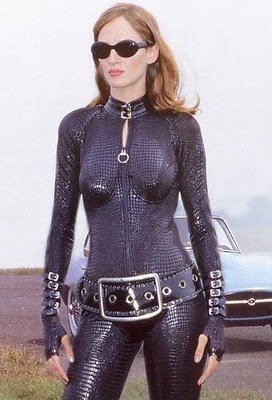
She also might have skinned Catwoman.
And now that I’ve reviewed it, I can comfortably wipe The Avengers from my memory banks.
Here’s a review of another would-be blockbuster. Or join Clint for a discussion of another TV show turned into a crappy movie.
Filed under: Projected Pixels and Emulsion, Yakmala! Tagged: embarrassment, Ralph Fiennes, Sean Connery, The Avengers, Uma Thurman

August 17, 2012
Now Fear This: Breakdown
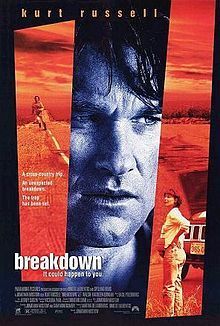
Kurt Russell seems unsure of this.
For a solid decade a single man reigned supreme over Hollywood as the greatest character actor of his age. He was the king of the That Guys, the actors you knew by sight but whose names were mysteries. He almost exclusively played antagonists, using impeccable elucidation and a reptilian glare like a samurai’s katana. This man was the incomparable J.T. Walsh. We lost Walsh tragically in 1999 of a heart attack, and the cinematic landscape is poorer for it. He made a career out of playing villains, most often cowards on the wrong side of bureaucracy who would torment our heroes from the safety of a desk. Occasionally, he would harness his anti-charisma into something much darker, as he did with the 1997 road movie thriller Breakdown.
Married couple Jeff and Amy (Kurt Russell and Kathleen Quinlan) have pulled up stakes from Massachusetts and are driving across the country to a new life in San Diego. In the sunbaked Arizona desert, they have the standard first act run-in with locals. Anyone who’s watched any hicksploitation knows that this is a clear recipe for trouble. Sure enough, this minor traffic snafu with a filthy pickup truck quickly turns sinister as the driver of the truck (M.C. Gainey, who has played terrifying rednecks in everything from Justified to Lost to Sideways) decides to give Jeff a piece of his mind at a convenience store. Shaken, Jeff drives away only to have his car break down a few miles along the road.
Luckily, a semi pulls up to help, but anyone familiar with movies from 1987-1999 knows Jeff is in trouble as soon as the driver gets out. It’s J.T. Walsh. Sure, he seems nice and helpful, but it’s J.T. Fucking Walsh, you it’s only a matter of time before those eyes go cold and that officious tone turns ominous. Walsh’s character, Red, gives Amy a ride to a nearby diner to call a tow truck, while Jeff chooses to stay with the car to insure no redneck-related shenanigans occur. About a half hour later, Jeff decides to check the car over, thinking he might have absorbed the necessary knowledge to fix it from the cosmos. While looking under the front bumper, he finds that a couple wires have been unplugged. He plugs them back in and the car starts up just fine. I don’t know anything about cars, so I’m assuming this is totally realistic.
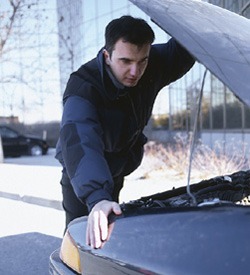
“Yeah, I think it’s the frammalator? That’s a thing, right?”
I am a suspicious and hateful soul, and would immediately howl sabotage if something like this happened after an encounter with M.C. Gainey. And frankly, I would never, ever, let my wife into a car with J.T. Walsh. And it’s not just people with initials for names, either. Or character actors whose work I consistently enjoy. I just have a negative opinion of rednecks.

I’m sorry, Dale. That was needlessly hurtful.
Jeff is far more trusting. He drives down the road to dusty Belle’s Diner and discovers that his wife never showed up, and Jeff, understandably, starts to panic. The locals don’t seem to care too much, and instead send him to the nearest town, thirty miles away, to talk to the sheriff. This gives some of the sense of scope of the lonely highways in this part of the world. On the way, he sees Red’s semi and gets him to pull over. And this is where the movie gets downright eerie. Red claims not to recognize Jeff, and damned if he’s not pretty convincing. The cops take Jeff’s statement, but the city boy is an outsider and he’s acting crazy. Meanwhile, reasonable Red could not be more accommodating and there is absolutely no evidence Amy was ever in the truck. Jeff continues to search, growing increasingly unhinged as the locals slowly morph from merely unhelpful to openly hostile. And then shit gets real.
I don’t want to reveal more about the plot of Breakdown because it really is a gem. It’s the kind of flick you don’t see anymore: a mid-budget thriller with recognizable faces that’s not about fucking teenagers. Relatively obscure and underrated, it is exactly the kind of movie I wanted to talk about when I started Now Fear This, a movie that could use a few more eyes. Itt stars Kurt Russell, the star of my favorite movie ever, and J.T. Walsh, who I’ve rhapsodized so much about, his estate is about to take a restraining order out on me. It’s the kind of film that should be experienced blind. Not because it will destroy your conception of reality, but because it’s a tense little pulp thriller that benefits from the audience being just as scared and confused as Kurt Russell’s Jeff.
Breakdown feels familiar to fans of ‘70s and ‘80s grindhouse because it is a strange combination of two genres. The first, as I mentioned, is hicksploitation fare like Deliverance or I Spit On Your Grave, a popular subgenre in the ‘70s as the rise of urban centers produced a disconnect with rural areas. In these stories, city dwellers wander into a countryside filled with angry hillbillies and bad things happen. Carol Clover points out that the rednecks are paradoxically hyper-masculine and yet emasculated by the exploitation of their environment. They’re resentful of the city dweller who is portrayed as soft and effeminate. Some act emasculates the city dweller (whether it’s kidnap, rape, murder, or some combination of all three), and he must reclaim his masculinity from these locals. Breakdown does this in Gainey’s first scene, and then more subtly later when Red looks over the engine and makes several remarks at Jeff’s expense, and then of course with Amy’s disappearance.
The film also shares some DNA with road movies like Duel, The Vanishing and The Hitcher. These deal more with psychopathy unconnected with any population subset. Though some of Red’s underlings speak with Southern twangs, Red himself has a somewhat neutral accent. He doesn’t seem to be doing what he does out of class resentment, nor is his environment being exploited. The villains of Breakdown share more in common with Raymond Lemorne or the faceless truck river from Duel. With most hicksploitation, there is the sense that the civilized world has it coming. They created the environment for evil, and though the protagonists might not specifically deserve what happens, there is a sense of chickens coming home to roost. Not so here, where Red and his allies are as soulless as The Hitcher’s John Ryder.
Breakdown works precisely because there is very little sense of rational motive to the crimes. It speaks to the universal fear of random violence, coupled with the anxiety over protecting one’s family. Most importantly, it’s an awesomely tense 90 minutes you won’t regret.
Louis discusses more redneck-related issues, or have a look at another Now Fear This entry.
Filed under: Projected Pixels and Emulsion Tagged: Breakdown, hicksploitation, J.T. Walsh, kurt russell, Now Fear This

August 10, 2012
Rules of Writing: The Lesson of Glorfindel
Chances are you remember the scene. Frodo is dying from the wound he received on Weathertop at the hands of the Witch King. That little cut is like a zombie bite: not only is it fatal, it’ll turn him into a hilariously tiny Nazgul. (Sadly, Mordor doesn’t have a sign that specifies “You Must Be At Least This Tall to be Evil.”) Aragorn’s best idea is rubbing some weeds on Frodo, while Pippin’s plan presumably involves second breakfast and knocking shit over until a balrog shows up. At this point, an elf rides up to help, and this is where things go pear-shaped.

Glorfindel.
Exactly which elf conveniently arrives depends on the version you best remember. In the books, it’s a character named Glorfindel, an ultra-powerful elf lord who is a paragon of good and righteousness, yet can’t be bothered with that troublesome business of saving the world. He appears in this scene and no other; it’s a terrible choice that makes the elves even more irritating and useless than they already are. If Glorfindel is truly good and powerful, shouldn’t he have made the Fellowship? They couldn’t shrug, and say the Fellowship could be ten guys? Or assume two hobbits counted as one person as long as they stood on each other’s shoulders? Or just throw one of them out? I mean, did we really need Merry AND Pippin? One of them couldn’t be swapped out for, you know, someone who could reach a kitchen counter? But that would mean Glorfindel actually, you know, doing something, which as it turns out is against the elvish religion. He never volunteers, and there’s never a discussion that maybe, just maybe, the good guys should send their heaviest hitters on a mission to save the world. The character highlights the problem with the elves: either they’re not as powerful as they want us to think, or they’re lazy douchebags. Glorfindel is worse than an unnecessary character. His existence actively undermines what Tolkien is telling us about elves.
Peter Jackson and Ralph Bakshi while adapting the books into films with varying degrees of success, both recognized this, and chose a different elf.
Jackson, realizing that Tolkien’s text was a bigger sausage fest than Top Gun, decided on Arwen, Aragorn’s love interest who spends most of her time trapped in a series of early ‘90s perfume commercials. On the surface it’s not a bad choice. The movie desperately needs a little estrogen or it’s going to start growing a beard and wearing Tapout shirts. By giving Arwen the Frodo rescue scene, Jackson makes Arwen look even worse than she already does. If she hung out at home, you could be like, “Okay sure, she’s not a warrior. She shouldn’t be out there kicking ass.” But she’s clearly a powerful enough sorcerer to summon those water horses, she manages to sneak up on a ranger, and she’s toting around that elf katana thing. When Arwen is confronted with the Witch King, her only solution is to run. While this momentary burst of action is admirable (especially in contrast to the other elves, who seem to only want to wander through the forest at night doing Enya parades), she immediately falls into ennui, lounging around on that bench and being horrified by mortality. Contrast this with Eowyn. The sight of the Witch King doesn’t do much more than piss her off. First she kills his riding monster, because fuck that thing, then she takes the time out to trash talk him before making him suck on her broadsword. Fuck Aragorn, why the hell wasn’t Eowyn in the Fellowship? I’ll tell you why: it would have been a single book, the last hundred pages of which would be Sauron openly weeping. Once again, a supposedly powerless human does something an elf can’t. Or, even more damning, won’t.
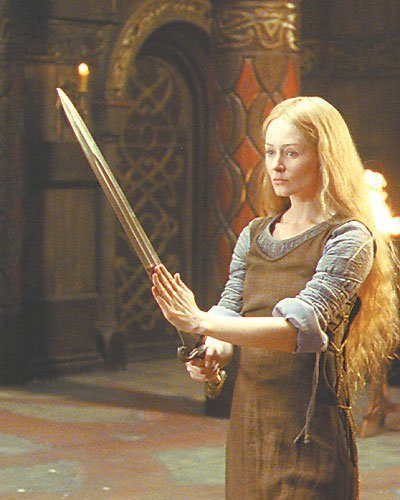
Alone, Eowyn dreams only of murder.
Bakshi’s movie is awful, but in this instance, he made the right call. The elf that shows up to help is Legolas, who you remember as that dreamy guy who would totally settle down if only he met you and got to know all your awesome quirks, like the way you just love otter mittens and Tibetan dubstep bands. As cool as he is, Legolas is a Mirkwood elf, and thus one of the less-powerful elves out there. But for all the power he allegedly lacks, he is the only one willing to lift a finger to save the world and fortunately, that finger was on his bowstring. Legolas kills orcs so bad, an entire generation of orcish women gave birth to arrows. Legolas is the correct choice because he is an established, important character in the story. Having him arrive cements Aragorn’s relationship with the elves, lets us meet a member of the Fellowship early, making one less character introduced suddenly at the conclave, and doesn’t open up any uncomfortable logic gaps. In fact, this would underscore how scary the Nazgul are, as Legolas rides like hell away from them, something more impressive considering his only reaction to an army of Uruk-Hai is a grim nod and a whispered, “Game on.”
Conservation of characters is important. Even if Glorfindel were just another Mirkwood elf, he would still be the wrong choice. Why have this character for just one scene? Wouldn’t saving Frodo’s life make for good motivation to join the Fellowship? Legolas is already headed to Rivendell, so there’s no awkward question of what he’s doing there. The fact is, Glorfindel is not just another Mirkwood elf. He’s an ultra-powerful elf lord, creating an even more important lesson for writers.
We need to be conscious of what our characters say about our worlds and our stories. Simply put, don’t have the Last of the Mohicans keep running into Mohicans. Don’t have Batman dress like a skunk. Don’t call Ishmael “Steve.” And so on. The world we create can have any rules at all, but once established, those rules must be obeyed. Any character introduced has to support those world laws. Like real people, characters work within the rules, although unlike real people, the rules are made up. A character, no matter how inconsequential to the plot should never undermine what the writer is trying to do. Like positing Glorfindel as a benevolent and powerful scion of a benevolent and powerful race, then having him do literally nothing else in a battle in which the fate of the world hangs in the balance.
But really, this is all secondary to a far more germane point, which is this: Fuck elves. Seriously, those guys are the worst.
For more hate, check out David’s piece on The Newsroom. For more weird fantasy racism from me, why not read up on my thoughts on trolls?
Filed under: Armchair Philosophy, Puffery Tagged: Glorfindel, J.R.R. Tolkien, Lord of the Rings, Peter Jackson, Ralph Bakshi, Rules of Writing

August 3, 2012
Revisiting Lost

Vrrrrrrmmmmmmm
This article is going to have a metric shit ton of Lost spoilers. So if you haven’t seen the series or want to watch it at some point without knowing what happens (something I recommend), you should probably leave now.
The promos looked pretty good. A bunch of recognizable actors survive a plane crash on some South Pacific island that has a monster on it for some reason. And hey, it had the guy from The Stepfather and Augustus Hill from Oz. The pilot for Lost looked interesting enough to check out. I was not disappointed. Whatever you may think of the rest of that show, by any objective viewpoint the pilot is an absolute masterpiece. I kept up with the show throughout its run, never escalating beyond casual, if loyal, fandom. I watched every episode once, and because of an article I had previously read in which JJ Abrams revealed he made up Alias as he went along, never speculated about the eventual resolution of the mysteries. I loved the show at times, hated it at others, and generally went through the normal cycle of the Lost fan, which is similar to being in an abusive relationship with a Buddhist monk. I was one of those who enjoyed the finale, and though it didn’t provide the perfect capstone the way the final episode of The Shield did, I felt it worked very well with what had come before, providing a satisfying resolution to plot and theme.
Mrs. Supermarket was working late on September 22, 2004, and thus missed the premiere. I desperately wanted her to watch it, but she demurred, saying she’d catch it at a later date. For my most recent birthday, a friend generously bought me the whole show (in that awesome pyramid box with the game and everything), and one evening when nothing was on, the missus and I started the show. After a slow start, we ended up plowing through the entire series, once putting away an auspicious 23 episodes over the course of a lazy weekend.
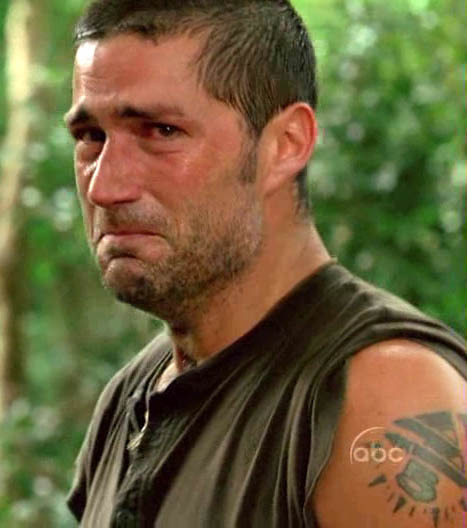
And watched Jack cry like 800 times.
We both enjoyed the show a great deal, and the experience was interesting to me for a couple reasons. Because I had only watched episodes once, and some of them eight years prior, my memories were spotty. I got to rediscover favorites (especially “Walkabout,” “Numbers,” and “The Other 48 Days”) and found new highlights (“Maternity Leave,” “Live Together, Die Alone,” and “Not In Portland”) that didn’t quite resonate with me the first time through. Some characters, Hurley especially, were just as beloved for me on the second go round, and some characters just as obnoxious. And no matter how much Kate might have irritated me, nothing can compare to Mrs. Supermarket’s white hot contempt.

“Kate ruins everything.” –Mrs. Supermarket
Desmond Hume is one of the most popular characters on Lost. Small wonder: he’s good looking guy with a soft Scottish brogue, inability to use buttons, enigmatic powers, and a love story sweeping in scope yet intimate in execution. He even has a cool catch phrase (“See you in another life, brother.”) Partly because of his popularity, Desmond slowly becomes one of the most important characters on the show. Yet, when he was introduced, I didn’t attach much significance to him, so I didn’t retain a ton of details from his story. Desmond’s unique relationship with time, as first explored in “Flashes Before Your Eyes,” an episode that bored me at the time but I love now and is at the fulcrum of the series. It’s even vitally important in the Sideways World. Yet this is a character introduced with maybe three episodes in the second season, is almost entirely absent for the fifth and much of the sixth. Lost should be watched in big chunks for many reasons, but none more compelling (or Scottish) than Desmond. The casual fan was not equipped to understand his importance.
The first knock anyone ever levels against the show is that it didn’t answer any of its mysteries, which is just false. Granted, some of the answers were unsatisfying. Worse still, some of the questions were delivered in a misleading way, making viewers believe that something was important that just wasn’t. Why was Libby in the asylum? Nervous breakdown maybe. Doesn’t matter. Who was Jack’s wife sleeping with? Not Charles Widmore, so it doesn’t matter. Why did Ben choose to terrorize Jack rather than just asking him nicely to remove the tumor? Because Ben is a dick.
The numbers bugged the shit out of me more than any of the other mysteries. They looked like the kind of thing the writers wanted to put everywhere without having the first clue of what they meant, and as they appeared more and more often, it became apparent that nothing could explain them. After their source were revealed in the sixth season, I was annoyed. The explanation offered was too small to justify the synchronicity of the numbers through the series. This time around, the numbers made warped kind of sense. All right, so the numbers correlate to the last six candidates, assigned according to the setting the magic lighthouse needed to spy on them (Jack’s at 23 degrees, so he’s 23, and so on). At first, I didn’t understand how the numbers would have been significant (stamped on the Swan Station, used as the computer code) before Jacob settled on those six people, or how the numbers would have been cursed to begin with. The Island exists out of time however, and to it, those numbers would already have been known. And as to why they’re cursed, they’re not. The Island was using them to bring Hurley to it to test his candidacy.
That’s right: the Island. Because the Island is a character with goals. You don’t know that on the first time through. Even late in the series, it’s easy to mix the Island up with Jacob and the Man in Black, both of whom are behind some of the supernatural phenomena. The interesting part is that neither Jacob nor the Man in Black truly understands what the Island is — it’s sort of unknowable, like the Old Testament God, with Jacob serving as a more dickish Jesus. Certain people — candidates — are important, and the Island will break natural laws to keep them breathing. The most tantalizing part of the series for me was that the Island itself was pretty much a deity, though one so alien it could neither directly communicate with people nor give a shit when someone unimportant was killed. Meanwhile, Jacob and the Man in Black were frantically guessing which of these people were important to a being they didn’t understand, and which could be used and discarded. One of the most important conversations occurs in one of the first couple episodes when Locke explains backgammon to Walt with the ominous decree, “there are two sides, light and dark.” On the Island that is quite literally true as Jacob and the Man in Black play a game with rules they don’t know and a goal they can only guess.

Uh… yahtzee?
Lost made a lot of narrative hay between the contrast of Jack, the man of science, with Locke, the man of faith. Both guys end up dead, because the show posits that neither science nor faith is the answer. The answer is each other, as shown in the Sideways World and appropriately it’s Hurley who truly “wins.” Neither a man of science nor of faith, Hurley is a man of man. He’s a humanist, a gentle soul, the one truly good person on that Island. The show even tells us this, as Charlie has a vision of Hurley as Jesus. There’s a reason the dead choose to talk to the guy, even if it’s just to stop by for a nice game of chess. Hurley even redeems Ben, transforming him from Judas into hopefully a less misogynistic version of Paul.
Some people hate this show. That’s fine. I even understand it to a degree. Not me. Lost is a flawed show, but it remains a stunning achievement both in long form fiction and television.
(For more on Lost check out Tim’s piece on the ten craziest moments. For other shows that aren’t nearly as good, check out my review of the Blossom pilot.)
Filed under: Projected Pixels and Emulsion Tagged: 15, 16, 23, 4, 42, 8, lost, television


